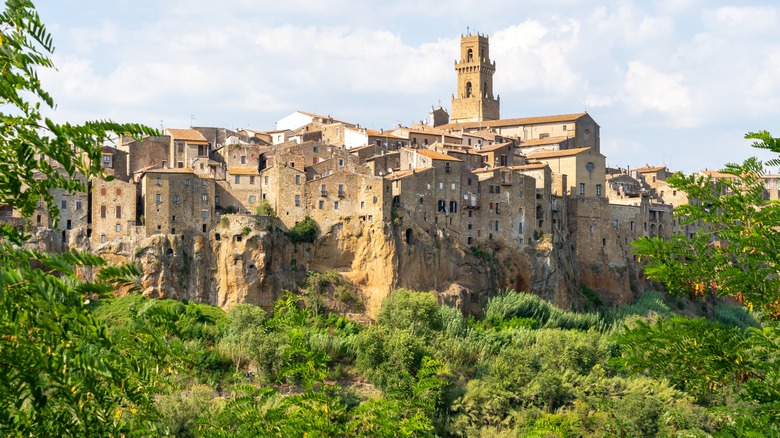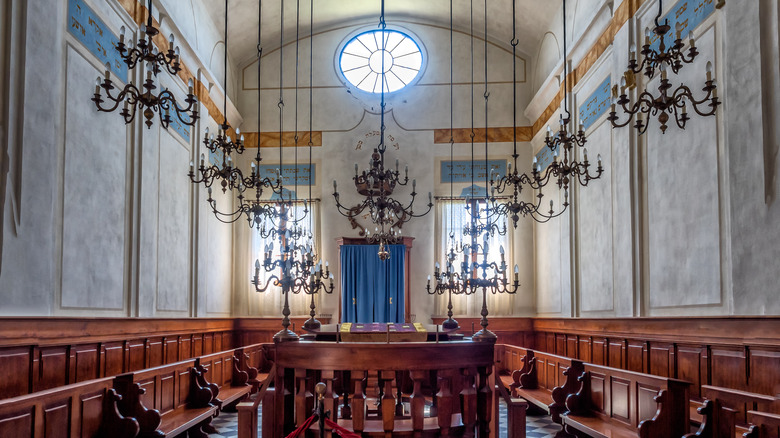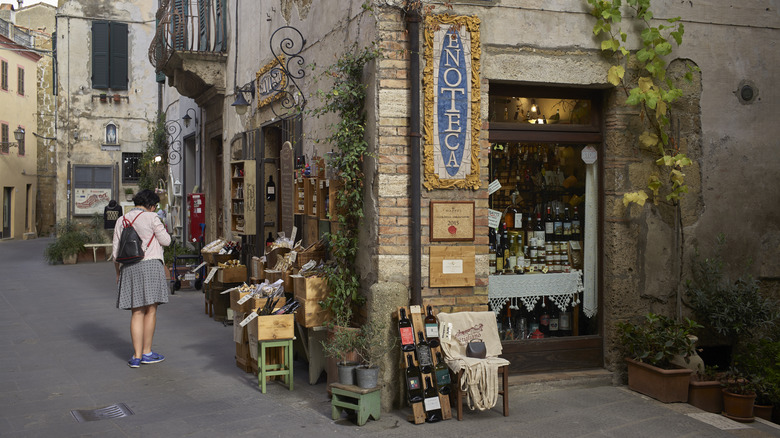Italy's Underrated 'Little Jerusalem' Is A Picturesque Medieval Village Perched On A Hill
Italy has no shortage of picturesque medieval villages, from a unique Scottish-Italian medieval town to Gangi, which was ranked as one the most beautiful in all of Italy, but there is only one with the title of "Little Jerusalem." In the Tuscan countryside, far away from the hustle and bustle of Florence, Venice, and Rome, lies the enchanting hilltop town of Pitigliano. Offering a captivating blend of history, culture, and natural beauty, Pitigliano is known as "La Piccola Gerusalemme" or "Little Jerusalem" due to its rich Jewish heritage. With its labyrinth of narrow streets, ancient buildings carved from volcanic rock, and stunning views of the Tuscan landscape, Pitigliano is a place that feels frozen in time — and might very well be one of Italy's best-kept secrets.
Perched dramatically over 1,000 feet above sea level on a tufa ridge in the province of Grosseto in southern Tuscany, Pitigliano's location alone is enough to make you stop and stare. Deservedly, Pitigliano is considered among the most beautiful Italian villages by the National Association of Italian Municipalities (ANCI). The village seems to rise from the cliff like a fairy-tale fortress of stone houses and medieval towers, hovering above the valley and the rivers of Lente and Meleta. This natural fortress-like position reflects the strategic importance the village once held across chapters from its past: Etruscan civilization (11th and 12th centuries B.C.), Roman presence, and ownership by the Alobrandeschi, Orsini, Medici, and Lorraine families, respectively, through the Middle Ages and Renaissance eras.
Pitigliano: a medieval gem with a Jewish heritage
But why "Little Jerusalem?" Nearly 500 years of history. Pitigliano's link to the Jewish community dates back to the early 16th century when many Jews found refuge here after being expelled from the Papal States, particularly Rome. The village became a safe haven for the Jewish diaspora — despite being confined to the ghetto, having to wear badges, and following a curfew — as they tried to integrate and contribute to cultural and economic life. At its height, 20% of Pitigliano's population was Jewish, and while the numbers have dwindled over the centuries (especially after World War II and the Holocaust), the legacy remains.
Visitors can explore the beautifully restored Synagogue of Pitigliano, originally built in 1598. Another notable site is the ancient Jewish cemetery, one of the oldest in Italy, where tombstones dating back hundreds of years can still be seen. The town's kosher wine cellar, mikveh (ritual bath for women), butcher, textile workshop, and bakery for unleavened Passover bread (matzah) are located in Pitigliano's historic ghetto. The Museum of Jewish Culture showcases many artifacts from this unique Judeo-Italian past.
Pitigliano also has plenty of medieval monuments worth exploring. The Orsini Palace, a grand building that was once the seat of the powerful Orsini family, now houses the Civic Archaeological Museum and the Palazzo Orsini Museum. And, surely, you can't miss the Medici aqueduct in the town center. The Santi Pietro e Paolo church, built in 1061 with its 35-foot bell tower, is another remarkable landmark, along with the Santa Maria church, San Rocco church, and the mysterious Tempietto, presumed to be an Etruscan tomb or a Roman temple. Without a doubt, Pitigliano is one of the best places to visit in Italy for history lovers.
Food, wine, and tips for your visit to Pitigliano
For an unmissable local specialty, try sfratti. This Jewish biscuit dessert is made of a thin sheet of sweet, buttery flour filled with a toffee made from honey, nuts, nutmeg, and orange zest. The name — in a bittersweet nod to the past — means "eviction," and the stick-like shape of the cookie represents the batons used by officers to keep Jews in the ghetto. Pitigliano cuisine also revolves around traditional Tuscan fare, with dishes like acquacotta, a soup made from vegetables, bread, and eggs, or pappardelle al cinghiale, a hearty pasta made with wild boar ragu.
Wine lovers will be happy to know that the town is part of the Bianco di Pitigliano DOC — one of the first to claim the title. The unique volcanic landscape and soil composition render this white wine a delicate, floral scent with a fresh, vibrant, dry mouthfeel. For red wine, try Morellino di Scansano or Sovana DOC. Wineries in the area offer tastings, so you can sample the region's wines and soak in the stunning countryside views all in one sip (or a few). If you come during Settembre diVino, which happens at the end of August every year, you'll be there for the festive opening of the wine cellars carved into the stone cliffs of the town.
To get to Pitigliano, your best bet is to rent a car and drive. Parking is available just outside the village's old town center. Driving will also allow you to visit the nearby villages of Sorano and Sovana, which are equally fascinating. Despite all these draws, Pitigliano remains relatively unknown to the masses, making it the perfect destination for savvy travelers looking to escape the crowds and explore something different and underrated.


